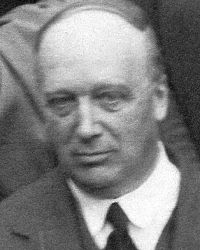Robert Strutt, 4th Baron Rayleigh facts for kids
Quick facts for kids
The Lord Rayleigh
|
|
|---|---|
 |
|
| Born | 28 August 1875 Essex, England
|
| Died | 13 December 1947 (aged 72) |
| Nationality | British |
| Education | Eton College |
| Alma mater | Trinity College, Cambridge |
| Known for | Rayleigh Rayleigh scattering |
| Spouse(s) |
Lady Mary Hilda Clements
(m. 1905; died 1919)Kathleen Alice Coppin-Straker
(m. 1920) |
| Children | 6 |
| Scientific career | |
| Fields | Experimental physics Chemical physics |
| Institutions | Imperial College London |
Robert John Strutt, 4th Baron Rayleigh (born August 28, 1875 – died December 13, 1947) was a British nobleman and a brilliant physicist. He made important discoveries about "active nitrogen." He was also the first to understand and describe the different kinds of light that make the night sky glow.
Early Life and Learning
Robert Strutt was born at Terling Place, his family's home in Essex, England. He was the oldest son of John William Strutt, who was the 3rd Baron Rayleigh. His mother was Evelyn Georgiana Mary. This also made him the nephew of a famous politician, Arthur Balfour.
He went to Eton College for school. Then he studied at Trinity College, Cambridge. He first started studying mathematics. But after a short time, he switched to Natural Sciences, which includes subjects like physics and chemistry.
He became a research student in physics at the Cavendish Laboratory. Here, he worked with a famous scientist named J. J. Thomson. Robert Strutt later wrote a book about Thomson's life. During this time, he studied how electricity moves through gases. This work included early studies on X-rays and electrons.
In 1904, he wrote one of the first books about radioactivity. It was called The Becquerel rays and the properties of radium. He received a special scholarship in 1898 and was a Fellow at Trinity College from 1900 to 1906. He earned his Master of Arts degree in 1901.
Science Career
In May 1905, Robert Strutt was chosen to be a Fellow of the Royal Society. This is a very high honor for scientists in the UK. He was recognized for his many discoveries in physics. He gave important talks called the Bakerian Lecture in 1911 and 1919. He also led the British Science Association from 1937 to 1938.
From 1904 to 1910, Strutt focused on figuring out the age of rocks and minerals. He did this by measuring how much radium and helium they contained. In 1908, he became a Professor of Physics at Imperial College London. There, he continued his father's work on how light scatters. This effect is now known as Rayleigh scattering. He also wrote a book about his father's life and work.
In 1910, Robert Strutt made an exciting discovery. He found that if you pass electricity through nitrogen gas, it creates "active nitrogen." This is a special form of nitrogen where the atoms are separate, not joined together. He observed a "whirling cloud of brilliant yellow light" that reacted with mercury to create an explosive substance.
In 1916, working with his friend Alfred Fowler, Strutt proved that ozone exists in the Earth's atmosphere. They did this by looking at the ultraviolet light from the setting sun. Strutt showed that most of the ozone was high up in the atmosphere. This area is now called the ozone layer, which protects us from harmful sunlight.
After his father passed away in 1919, Strutt left his teaching job at Imperial College. However, he kept doing experiments at home. He used a private laboratory that his father had set up. He continued his earlier work on how gases glow and how light is produced. This led him to study the light from the night sky.
He was the first to tell the difference between two types of night sky light. One is the aurora, also known as the "northern lights." The other is called airglow. Airglow is a faint light that makes the sky never completely dark, even without city lights. In 1929, he was the first to measure how bright this airglow was. Because of this work, he was later nicknamed "the Airglow Rayleigh."
The rayleigh is a unit used to measure the brightness of airglow. It is named after him to honor his important contributions.
Family Life
When his father died in 1919, Robert Strutt became the 4th Baron Rayleigh. He was married two times. His first wife was Lady Mary Hilda Clements. They married in 1905, and she passed away in 1919. In 1920, he married Kathleen Alice Coppin-Straker.
He had five children with his first wife, though one died when they were young. His children included:
- John Arthur Strutt, who became the 5th Baron Rayleigh.
- Hon. Charles Richard Strutt, whose son is the current 6th Baron.
- Hon. Daphne Strutt, who had 11 children.
- Hon. Hedley Vicars Strutt, who served in World War II.
He had one more child with his second wife:
- Hon. Guy Robert Strutt.
Robert Strutt died in Terling, Essex, in 1947.
See also


